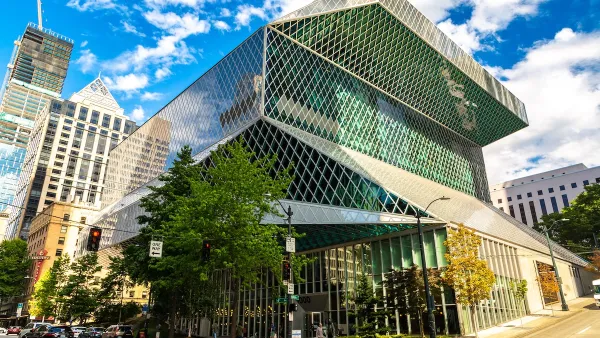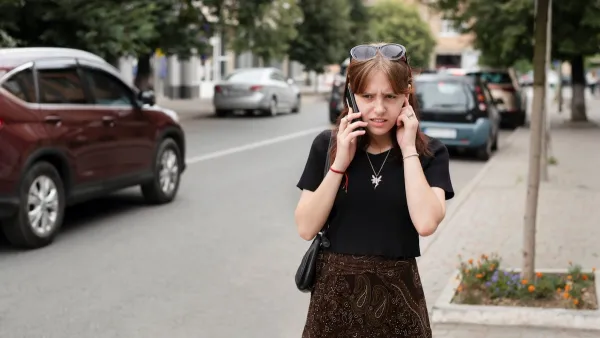A recent event organized by Good Magazine, Sheridan/Hawkes Collaborative and The Public Studio brought together about 30 civic-minded designers, planners and architects to come up with some ways to improve the urban environment of Los Angeles. It was a big question to tackle in one afternoon, with a huge array of possible solutions. The crowd was split up into five separate groups and surprisingly, each came up with a similar answer: taco trucks. OK, not taco trucks specifically, but the essence of taco trucks and what they bring to the city.
A recent event organized by Good Magazine, Sheridan/Hawkes Collaborative and The Public Studio brought together about 30 civic-minded designers, planners and architects to come up with some ways to improve the urban environment of Los Angeles. It was a big question to tackle in one afternoon, with a huge array of possible solutions. The crowd was split up into five separate groups and surprisingly, each came up with a similar answer: taco trucks. OK, not taco trucks specifically, but the essence of taco trucks and what they bring to the city.
They're informal, they're impermanent-yet-reliable, they're small local business, and they activate the street. Overall they represent a unique blend of private business and public space that puts dollars in the local economy and eyes on the streets.

A bunch of people trying to make L.A. better. (Photo by Eric Drachman)
That's how taco trucks came to be a central element of the ideas in each of the plans devised by these five groups of civic-minded people to improve the city of Los Angeles. The group into which I added my meager two cents used the idea of the taco truck as a launching pad for a broader vision of established 'flexible' zones that could harbor a variety of temporary uses, both public and private. As we quickly bounced ideas off of each other, one revelation stuck out to me and that was the absence of that unique blend of private and public in most development projects. Sure, there are public plazas in front of skyscrapers and outdoor seating at cafes, but not too many instances where the public-ness doesn't seem tacked on or the private-ness doesn't seem like an invasion. The lines between public and private are appropriately clear, but do their physical locations have to be as distinctly separated?
Think of a typical mixed use project, a building with a few retail shops on the street level and some apartments on the floor or two above. The proximity creates an implicit connection between resident and local (or at least nearby) merchants, forms an economic bond and activates the street to make a livelier, more vibrant neighborhood. So you have private homes and private businesses and you throw in some shoppers and you've got a mixed-use, mixed-activity space. Granted, that arrangement might not be right for everyone or every place, but the resulting benefits to streetlife are pretty clear, I think.
But what if there were space within that project for public meetings, or a rentable kiosk space in front of the building where fruit peddlers could stand, or an open space that holds vendors during the day and outdoor events at night? Mixed use, it sometimes seems, just isn't mixed enough. Maybe mixed use needs to get mixier. Should publicly available space be zoned into new projects? Maybe, but that prospect opens a lot of questions about what "public" really means. Should temporary spaces be able to house multiple types of uses depending on the time of day and season? It might work, with the right combination of entrepreneurship, market forces and administration. Maybe it's easier said than done, but I think it's worth considering. The mixed use projects we've seen in recent years are an improvement from the single-use zoning chokehold of the past, but simply limiting our developments to a mix of two or three uses might not be doing enough to create more active and attractive places in our cities.

Analysis: Cybertruck Fatality Rate Far Exceeds That of Ford Pinto
The Tesla Cybertruck was recalled seven times last year.

National Parks Layoffs Will Cause Communities to Lose Billions
Thousands of essential park workers were laid off this week, just before the busy spring break season.

Retro-silient?: America’s First “Eco-burb,” The Woodlands Turns 50
A master-planned community north of Houston offers lessons on green infrastructure and resilient design, but falls short of its founder’s lofty affordability and walkability goals.

Test News Post 1
This is a summary

Analysis: Cybertruck Fatality Rate Far Exceeds That of Ford Pinto
The Tesla Cybertruck was recalled seven times last year.

Test News Headline 46
Test for the image on the front page.
Urban Design for Planners 1: Software Tools
This six-course series explores essential urban design concepts using open source software and equips planners with the tools they need to participate fully in the urban design process.
Planning for Universal Design
Learn the tools for implementing Universal Design in planning regulations.
EMC Planning Group, Inc.
Planetizen
Planetizen
Mpact (formerly Rail~Volution)
Great Falls Development Authority, Inc.
HUDs Office of Policy Development and Research
NYU Wagner Graduate School of Public Service



























